It’s not just about demonstrating your knowledge, but also about contributing something new to your field of study. For many, the thought of writing a dissertation can be daunting.
This in-depth guide aims to demystify the dissertation writing process, offering a clear and structured approach to what can often feel like an overwhelming task.
In this guide, you will learn:
- The essentials of what is a dissertation and its academic significance and purpose.
- Key insights into how long is a dissertation and tailoring its length.
- A practical guide on how to write a dissertation step by step and some examples.
- The challenges and do’s and don’ts of writing a dissertation.
Let’s dive into the world of dissertation writing. From the initial question of what is a dissertation to the final touches of your scholarly work, this guide covers it all.
What is a Dissertation?
Firstly, let us understand what is a dissertation.
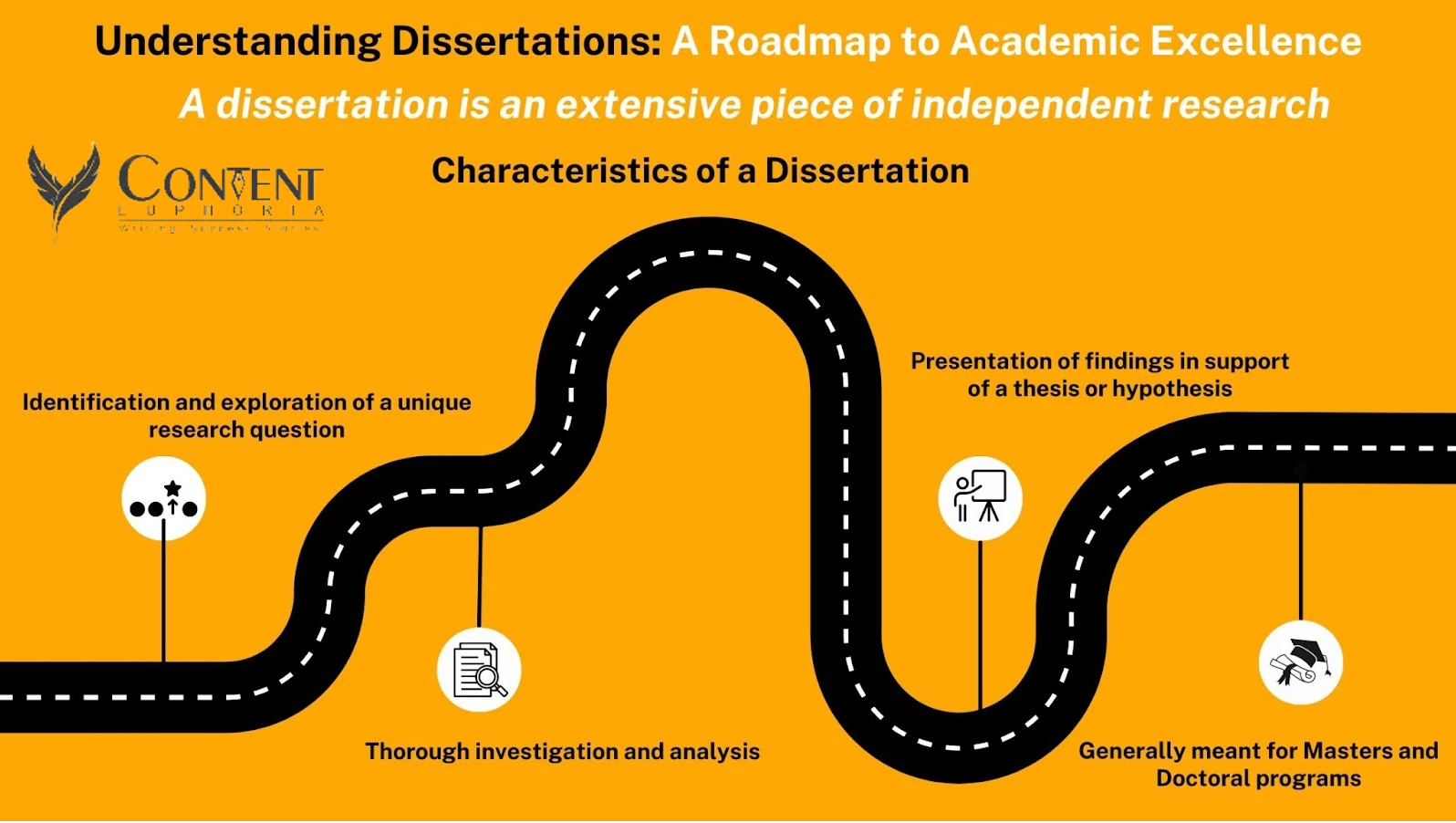
At its core, a dissertation is a substantial piece of independent research. The purpose of a dissertation is to contribute new knowledge or insights to your field of study. It involves identifying a research question, conducting thorough research, and presenting your findings and conclusions in a well-organized and academically rigorous format.
In essence, a dissertation:
- Is a substantial piece of independent work, often forming a significant part of a postgraduate degree.
- Requires the identification of a unique research question, followed by thorough investigation and analysis.
- Culminates in a document that presents findings and argues in support of a specific thesis or hypothesis.
Types of Dissertation
Dissertations fall into two main categories: empirical and non-empirical, each suited to specific academic disciplines:
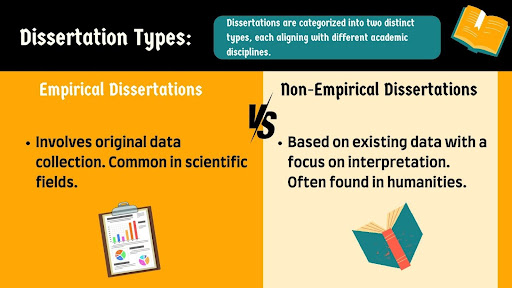
- Empirical Dissertations: In empirical (or quantitative) dissertations, typical within scientific fields, students undertake original data collection and submit their research methodologies for examination.
- Non-empirical Dissertations: Non-empirical (or qualitative) dissertations, often found in the humanities, draw upon pre-existing data, demanding from students innovative and unique interpretations.
It is a culmination of years of study and research, a testament to a student’s dedication and expertise in their chosen field. It represents a final hurdle in one’s academic journey, usually at the end of a Ph.D. program, but sometimes included in Master’s courses as well. Unlike typical essays or assignments, a dissertation is a much more comprehensive task, requiring an in-depth exploration of a specific subject.
Unique Characteristics of a Dissertation:
- Length and Depth: A dissertation is notably longer than typical college assignments and essays. It’s a detailed study, often stretching to several tens of thousands of words. The length allows for a thorough examination of a topic, presenting complex arguments, methodology, and results in detail.
- Original Research: One of the key aspects of a dissertation is its focus on original research. Students are expected to contribute new findings to their field of study, which means conducting original research, proposing new theories, or developing unique interpretations of existing data.
- Independent Work: While students receive guidance from academic advisors, a dissertation is largely an independent project. It’s an opportunity for students to demonstrate their ability to conduct research independently, manage a large-scale project, and communicate their findings effectively.
- Specialization: Dissertations enable students to specialize in a niche within their academic discipline. Through this process, they become experts in a specific area, which can set the foundation for their future academic or professional focus.
- Academic Rigor: The process of creating a dissertation is rigorous. It involves identifying a research question, conducting thorough research, analyzing data, and presenting the findings in a clear and structured manner. This process requires a high level of academic skill and discipline.
The dissertation process is not only about contributing to your field of study but also about personal and professional growth. It hones research skills, critical thinking, and academic writing abilities, which are invaluable in many career paths.
Dissertation vs. Thesis: Understanding the Difference
While the terms ‘dissertation’ and ‘thesis’ are often used interchangeably in some regions, they can denote different things based on the academic context. In the United States, for instance, a thesis typically refers to a final project for a master’s degree, while a dissertation is reserved for doctoral-level study. Conversely, in many European countries, ‘dissertation’ may refer to a master’s level thesis, and the term used for a doctoral thesis might be different.
The key difference between the two lies in their level of depth and complexity. A master’s thesis is expected to show mastery of the existing scholarship in a specific subject and to contribute to that scholarship in a meaningful way. A doctoral dissertation, on the other hand, is expected to contribute new knowledge to the field, offering fresh insights and original research that can advance understanding in the discipline.
Both a thesis and a dissertation require a thorough understanding of the subject matter, rigorous research, and a clear presentation of the findings. However, the expectation for original contribution and the scope of research is significantly higher in a dissertation. The process of writing a dissertation also involves more steps, including a proposal phase, extensive literature review, methodology, data collection and analysis, and an in-depth discussion of the results.
Purpose of Writing a Dissertation
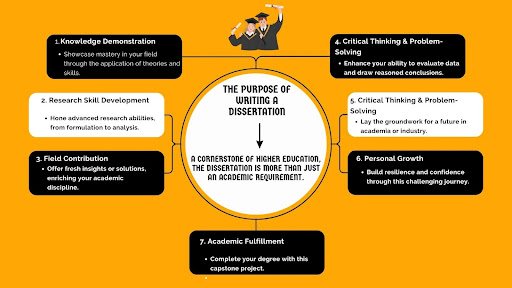
We now know what is a dissertation. Writing a dissertation is a significant milestone in the journey of higher education, embodying the essence of research and critical thinking skills. This comprehensive academic exercise serves multiple crucial purposes in a scholar’s academic and professional development.
-
Demonstration of Extensive Knowledge:
A dissertation is an opportunity for students to demonstrate their thorough understanding of their field of study. It requires the application of theories, concepts, and skills gained throughout their academic journey, showcasing their mastery over the subject matter.
-
Development of Research Skills:
One of the primary purposes of a dissertation is to develop advanced research skills. This process involves identifying a unique research question, conducting a comprehensive literature review, choosing appropriate methodologies, and analyzing data. These skills are not only vital for academic success but are also highly valued in many professional settings.
-
Contribution to the Field:
Dissertations contribute to the body of knowledge in a specific field. Through original research, students can address unanswered questions, offer new perspectives, or provide solutions to existing problems. This contribution is crucial for the ongoing evolution of any academic discipline.
-
Cultivation of Critical Thinking and Problem-Solving Skills:
The process of writing a dissertation sharpens critical thinking and problem-solving abilities. Students learn to critically analyze literature, data, and their own findings, leading to well-reasoned conclusions. These skills are essential for effective decision-making in various real-world scenarios.
-
Preparation for Academic and Professional Careers:
Completing a dissertation prepares students for academic careers, where research and publication are integral. It also equips them with skills and knowledge applicable in various industries, making them valuable assets in the professional world.
-
Personal Growth and Confidence Building:
The journey of completing a dissertation is also a personal one. It challenges students to manage their time effectively, overcome obstacles, and persevere through complex tasks. Successfully completing this rigorous academic requirement significantly boosts confidence and self-efficacy.
-
Fulfillment of Academic Requirements:
Finally, a dissertation is often a requirement for completing a degree, especially at the master’s and doctoral levels. It serves as a capstone project that synthesizes learning and research skills, marking the culmination of the student’s academic efforts.
How Long is a Dissertation?
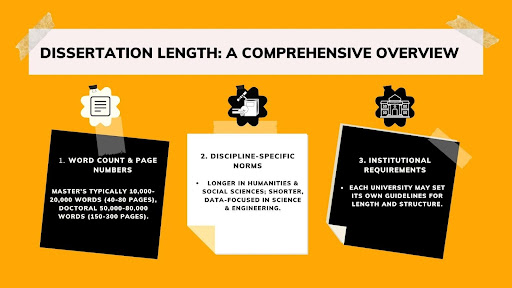
Now, let us understand how long is a dissertation.
The length of a dissertation can vary significantly across different fields of study, institutions, and even countries. However, there are general guidelines that can give us an idea of what to expect while dissertation writing:
1. Word Count and Page Numbers:
- Typical Range: Most dissertations are between 10,000 to 20,000 words for master’s programs, and between 50,000 to 80,000 words for doctoral programs.
- Page Numbers: Translating to pages, this range is roughly 40-80 pages for master’s theses and 150-300 pages for doctoral dissertations, depending on formatting and inclusion of elements like figures, tables, and bibliography.
2. Discipline-Specific Norms:
- Humanities and Social Sciences: Dissertations in these fields tend to be longer due to the nature of qualitative research and a heavy reliance on extensive literature reviews and theoretical discussions.
- Science and Engineering: Conversely, dissertations in scientific fields may be shorter but include detailed data, methodologies, and the results of experimental work.
3. Institutional Requirements:
- Each university or academic institution may have its specific guidelines that dictate the expected length and structure of dissertations.
It’s essential to remember that the length of a dissertation is less important than its quality. A well-researched, clearly written, and well-argued dissertation is always more valuable than its length.
Dissertation Structure and Requirements
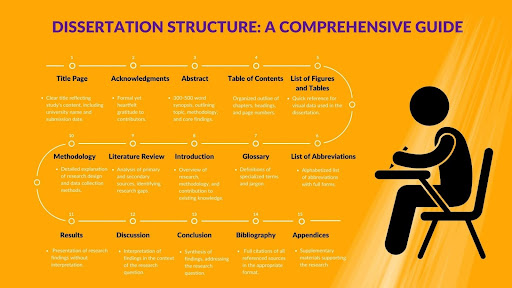
Now you understand the purpose of a dissertation and how long is a dissertation. Let us understand the dissertation structure.
A dissertation is typically structured in the following way:
1. Title Page:
The title page is the frontispiece of your dissertation, showcasing the title which should be a precise yet comprehensive reflection of your study’s content. It serves as a clear indicator of your dissertation’s subject matter, aligning seamlessly with your research question or thesis statement.
- The formulation of the title is such that it provides a clear and immediate understanding of the topic under investigation.
- The layout of the title page often varies based on institutional guidelines and formatting styles.
- Typically, it includes essential details like the name of the university, your specific program or department, and the date of submission.
It’s advisable to consult your academic advisor or follow the university’s prescribed format to ensure adherence to specific academic standards.
2. Acknowledgments:
This section, while optional, offers a personal touch to your dissertation. It’s an opportunity to express gratitude towards individuals who have supported or contributed to your academic journey and the completion of your dissertation.
- This could include academic mentors, peers, family, or anyone else who has played a significant role in your research process.
- The tone of the acknowledgments should be formal yet heartfelt, acknowledging the support received without extensive elaboration.
Brevity and sincerity are key, as this section sets a tone of humility and gratitude for the reader before delving into the academic rigor of your work.
3. Abstract:
The abstract is a concise and potent summary that precedes the main body of your dissertation.
- Typically ranging from 300 to 500 words, it effectively encapsulates the essence of your research, highlighting key aspects such as the main topic, methodology, and the core findings.
- The abstract is crafted to give readers a quick yet thorough overview of what to expect in the dissertation, serving as a standalone synopsis that can also guide readers in understanding the relevance and scope of your study.
It’s important to differentiate between an abstract and an executive summary. While both serve as summaries, an abstract does not delve into the conclusions or findings of the research, unlike an executive summary. The abstract’s primary goal is to provide a clear and concise description of the research conducted, its methodology, and a glimpse into the results, paving the way for a detailed exploration in the subsequent sections.
4. Table of Contents:
The table of contents is a navigational tool that outlines the dissertation’s structure, listing chapters, headings, subheadings, and their corresponding page numbers.
This element is crucial for providing clarity and ease of access to specific sections of your work. It also includes listings for supplementary materials like the bibliography, appendices, and optional sections such as a glossary or a list of figures and tables.
The meticulous organization in the table of contents reflects the comprehensive and systematic approach of your research, guiding the reader through the flow of the dissertation.
5. List of Figures and Tables:
In dissertations that are rich in data and require visual aids for better understanding and presentation, a separate list of figures and tables is included.
- This list, similar to the table of contents, details all the figures and tables used in the dissertation, along with their respective page numbers.
- It functions as a quick reference point for readers to locate and interpret visual data such as graphs, charts, diagrams, and tables.
This list is particularly beneficial in enhancing the readability of data-heavy dissertations, allowing readers to easily navigate through complex information.
6. List of Abbreviations:
Dissertations often employ specific terminologies and abbreviations, particularly those that are specialized to a field of study. To aid reader comprehension, a list of abbreviations is provided, usually at the beginning of the document.
- This list offers an alphabetized reference of all abbreviations used in the text, along with their full forms.
- The inclusion of this list is vital in making your dissertation accessible to readers who may not be familiar with these specialized terms.
It ensures that your work remains clear and comprehensible, avoiding any potential confusion or misinterpretation of key terms.
7. Glossary:
The glossary in a dissertation serves as an essential reference tool, especially in papers that utilize specialized terminology or complex language.
- This section acts similarly to a mini-dictionary, where specific terms, phrases, or jargon are alphabetically listed along with their definitions.
- The primary purpose of including a glossary is to ensure clarity and enhance the reader’s understanding, particularly for those not familiar with the specific language or technical terms used in the dissertation.
It’s a thoughtful addition that caters to a broader audience, ensuring that the dissertation remains accessible and comprehensible to readers across various fields.
8. Introduction:
The next component of a dissertation structure is the introduction. The introduction of a dissertation is a critical component that sets the stage for the entire study. It serves as the gateway to your research, providing a clear overview of what the paper is about and succinctly stating the research question or thesis statement.
- The introduction lays the foundation by offering necessary background information, helping readers understand the context and significance of your research.
- Additionally, it outlines the research methodology and approach in a summarized form, without delving into excessive details.
- The introduction also positions your research within the existing body of knowledge, highlighting how your work contributes to or differs from previous studies.
Typically, the length of the introduction is about 10% of the total dissertation, serving as a concise yet comprehensive gateway into your research.
9. Literature Review:
This section delves into the existing research related to your dissertation topic.
- It involves a critical analysis of both primary and secondary sources, identifying the current state of knowledge, ongoing debates, and any significant questions or gaps in existing research.
- The literature review not only synthesizes the existing work but also positions your research within the broader academic conversation, highlighting the unique contribution your study is poised to make.
- It’s important to note the ‘research gap’ that your dissertation addresses and to outline the theoretical framework you’re building upon.
10. Methodology:
This chapter is crucial as it lays out the design and methodology of your research. It should comprehensively explain your approach to collecting and analyzing data, justifying the methods chosen and discussing their limitations.
- For empirical research, this might include descriptions of experiments, surveys, or fieldwork.
- For theoretical dissertations, it may involve a discussion of the approach to textual analysis or philosophical inquiry.
This section should be detailed enough to allow replication of your study and should address any ethical considerations involved in your research.
11. Results:
This section presents the findings of your research without any personal bias or interpretation. In empirical dissertations, this could mean statistical data, while in theoretical work, it could involve the presentation of critical analysis.
- It’s crucial to organize your results logically, perhaps by research question, hypothesis, or thematically.
- The results should be clearly stated, using tables, graphs, or diagrams where appropriate to aid in the clarity and comprehension of the data presented.
Remember, this section is just about presenting what you found, not interpreting it – that’s for the next chapter.
12. Discussion:
The discussion chapter in a dissertation involves interpreting and examining the implications of the findings.
- This section is where the researcher delves into what the results actually mean in the context of the research question and the broader field.
- It assesses whether the findings align with the theoretical framework established earlier and explores their impact on existing knowledge and future research.
- The discussion often includes a reflection on any surprising or unexpected outcomes, providing an opportunity for the researcher to express their insights and interpretations.
This transparency helps build credibility and offers a more nuanced understanding of the research.
13. Conclusion:
The conclusion chapter is where the research journey culminates.
- It synthesizes the findings, drawing them back to the original thesis statement or research question to emphasize how they have contributed to the understanding of the topic.
- This section often includes implications for future research, acknowledging the limitations of the current study and suggesting areas for further exploration.
The conclusion is not a place for introducing new data or ideas; rather, it revisits the key findings and reinforces the significance of the research.
14. Bibliography:
A comprehensive bibliography is an integral part of any dissertation, providing full citations for all the sources referenced throughout the research.
- It includes detailed publishing information for each source, adhering to the specific citation style chosen for the dissertation, such as APA, MLA, or Chicago.
- This part of the dissertation demonstrates the extent of the research and provides readers with the resources to explore the topic further.
- The format of the bibliography should strictly follow the guidelines of the chosen citation style to ensure consistency and accuracy.
15. Appendices:
The appendices section of a dissertation includes supplementary materials that are relevant but not essential to the main text.
- These materials can range from detailed data tables, maps, interview transcripts, questionnaires, or additional explanations that support the research but would disrupt the flow of the main content if included in the body.
- Each item is designated as an individual appendix and is referred to within the main text where relevant.
Appendices provide depth and transparency to the research, allowing interested readers to delve deeper into the methodology and data.
Having understood the dissertation structure lets us understand key dissertation requirements.
Key Dissertation Requirements
- Originality: Your dissertation should contribute new knowledge or perspectives to your field of study.
- Rigor: Your research must be thorough and methodologically sound.
- Formatting: Adhere to specific formatting guidelines as required by your institution, including font size, margins, and citation style.
- Timely Submission: Meet all deadlines set by your department or university for proposal submission, drafts, and final submission.
Understanding these structural elements and dissertation requirements is crucial for planning and executing your dissertation effectively. By comprehensively covering each component, you can ensure that your dissertation not only meets but exceeds the expectations of your academic committee.
How to Write a Dissertation Step by Step
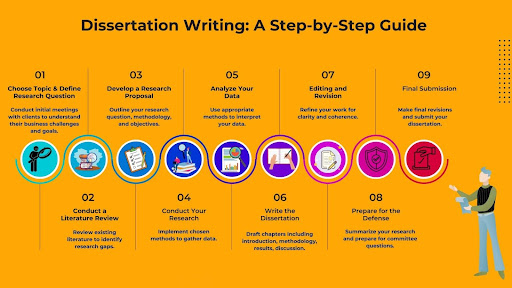
So, how to write a dissertation step by step, you ask?
To help you navigate this crucial task, let’s break down the process into manageable steps.
1. Choose Your Topic and Define the Research Question:
The first step is selecting a topic that interests you and contributes something new to your field. Once you have chosen a topic, define your research question. This will guide your research and frame your study.
| Tips to choose your dissertation topic
Here are a few points on how to choose your topic:
|
Example: Let’s say you’re studying environmental science. A potential dissertation topic could be “The Impact of Urbanization on Coastal Ecosystems.” This topic is specific, researchable, and relevant to your field of study.
| Pro-Tip: Brainstorm ideas, discuss them with your advisor, and conduct preliminary research to ensure there’s enough material available on the subject. |
2. Conduct a Literature Review:
Before diving into your research, it’s crucial to understand the current state of knowledge in your field. A comprehensive literature review will help you identify gaps in the existing research that your dissertation can address.
Example: For the chosen topic, you would start by reviewing existing literature on urbanization’s effects on ecosystems, particularly coastal ones. This might involve reading scientific journals, articles, and case studies about coastal cities worldwide.
| Pro-Tip: Use a range of sources, critically evaluate them, and organize them thematically. |
3. Develop a Research Proposal:
This step often involves presenting your proposal to a committee or advisor for approval. Your proposal should outline your research question, methodology, and how you plan to contribute to your field.
Example: Your proposal for studying urbanization’s impact on coastal ecosystems might include your research question, hypothesis, a brief literature review, and the methods you plan to use for your research.
| Pro-Tip: Use a range of sources, critically evaluate them, and organize them thematically. |
4. Conduct Your Research:
This is the core of your dissertation. Whether you’re conducting experiments, surveys, or qualitative interviews, ensure your methods are sound and replicable.
Example: You might conduct field studies in various coastal cities, gather data on urban development, pollution levels, and the health of coastal ecosystems, and interview local environmental experts.
| Pro-Tip: Keep detailed records, be systematic in your approach, and ensure data reliability. |
5. Analyze Your Data:
Once you’ve gathered your data, it’s time to analyze it. Use appropriate methods to extract meaningful insights relevant to your research question.
Example: After collecting data, you organize it into meaningful patterns. For instance, you might find a correlation between the rate of urbanization and the decline in certain marine species in coastal areas.
| Pro-Tip: Choose appropriate analysis methods, and be prepared to revise your approach based on the data. |
6. Write the Dissertation:
Begin with drafting the chapters as outlined in your university’s guidelines. Typically, this includes an introduction, literature review, methodology, results, discussion, and conclusion.
Example: Your writing would start with an introduction to urbanization and its potential impacts on ecosystems, followed by your methodology, the results of your research, and a discussion on what these results mean in the context of environmental science.
| Pro-Tip: Write clearly, follow your institution’s guidelines, and frequently reference your research question. |
7. Editing and Revision:
Writing a dissertation is a process of continuous refinement. Edit your work for clarity, coherence, and conciseness. Seek feedback from your advisor or peers.
Example: After your first draft, you might realize you need to clarify certain points or include additional data on urban policies affecting coastal ecosystems. This stage involves refining your dissertation to ensure clarity and coherence.
| Pro-Tip: Seek feedback from advisors and peers, take breaks to return with fresh eyes, and consider using dissertation help from Content Euphoria’s professional dissertation writing services. |
8. Prepare for the Defense:
Most programs require you to defend your dissertation before a committee. Prepare a presentation summarizing your research and be ready to answer questions and discuss your findings.
Example: For your defense, you prepare a presentation summarizing your research findings, anticipating possible questions like “How can urban planning reduce the negative impact on coastal ecosystems?” and preparing thoughtful responses.
| Pro-Tip: Practice your defense, be confident in your knowledge of the subject, and be open to constructive criticism. |
9. Final Submission:
After your defense, you may need to make final revisions. Once completed, submit your dissertation in the required format to your department or university.
Remember, writing a dissertation is a marathon, not a sprint. Manage your time effectively, seek support when needed, and maintain a positive outlook. Your dissertation can be a rewarding process that not only contributes to your field but also fosters personal and professional growth.
5 Simple Ways to Write a Dissertation
Now you know how to write a dissertation step by step. Let us now look at 5 ways that can make your dissertation writing task easier.
Writing a dissertation can be a daunting task, but breaking it down into manageable steps can simplify the process. Here are five straightforward ways to approach your dissertation:
1. Choose a Focused, Compelling Topic
Your dissertation topic should be both specific enough to cover in-depth and broad enough to find adequate research and sources. For example, if you’re studying psychology, instead of choosing a general topic like “stress,” you might narrow it down to “the impact of mindfulness meditation on stress reduction among college students.”
2. Develop a Clear Thesis Statement
This is the foundation of your dissertation. It should state what you will be studying, what you aim to prove or discuss, and why it matters. Using the previous example, a thesis statement might be, “This study aims to demonstrate how mindfulness meditation can significantly reduce stress levels in college students, potentially improving their academic performance and mental health.”
3. Create a Detailed Outline
An outline is a roadmap for your dissertation. It should include all the major sections: introduction, literature review, methodology, results, discussion, and conclusion. For each section, list the key points or arguments you plan to cover. For instance, under methodology, you might note the specific techniques used to gather data, like surveys or experimental procedures.
4. Gather and Analyze Data Methodically
If your dissertation involves primary research, develop a systematic approach to gathering and analyzing data. For qualitative research, this might involve conducting interviews and then coding the responses. For quantitative research, it could involve conducting experiments and using statistical methods to analyze the results.
5. Write Regularly and Seek Feedback
Dissertation writing is a marathon, not a sprint. Set a regular writing schedule and stick to it. Regularly review what you’ve written and be open to revisions. Seeking feedback from your advisor or peers can be invaluable. They can offer insights you might not have considered and help refine your arguments and structure.
Dissertation Examples
Writing a dissertation can often feel like navigating uncharted waters. To help you gain a better understanding and find your own path, let’s explore some practical examples that illustrate how to effectively structure and compose a dissertation.
Dissertation Examples: A Dissertation in Social Sciences
Topic: The Impact of Social Media on Political Awareness in Young Adults
- Abstract: This study investigates how social media platforms influence the political awareness and engagement among young adults aged 18-24.
- Introduction: Here, the focus is on establishing the relevance of social media in the current political landscape, particularly among the youth. The introduction sets the stage by providing statistics on social media usage and political engagement patterns among young adults.
- Literature Review: This section delves into existing research on social media, political awareness, and youth engagement. It synthesizes the gap in current literature that this dissertation aims to fill.
- Methodology: The research uses a mixed-method approach, combining qualitative interviews with quantitative survey data. This section details the sample size, data collection methods, and analysis approach.
- Findings: The analysis reveals a positive correlation between social media usage and political awareness but also highlights the presence of misinformation and its impact.
- Discussion: This part interprets the findings in the context of existing literature, discussing the implications for policy and future research.
- Conclusion: Summarizes the study’s contributions to the field, its limitations, and suggestions for further research.
Dissertation Examples: A Dissertation in Natural Sciences
Topic: Examining the Effects of Urbanization on Local Bird Populations
- Abstract: This research explores how urban development affects bird species diversity and population in a mid-sized city.
- Introduction: The introduction outlines the context of urbanization and its potential impact on local wildlife, specifically bird populations.
- Literature Review: Reviews existing research on urban ecology, focusing on avian life, to build a foundation for the study.
- Methodology: Describes the fieldwork conducted, including observational methods and statistical tools used for analyzing bird population data across different urban areas.
- Findings: Presents the data on bird species diversity and population density, showing noticeable variations between heavily urbanized and suburban areas.
- Discussion: Discusses the findings in light of urban ecological theories, drawing connections with broader environmental concerns.
- Conclusion: Concludes with a summary of the research findings, their implications for urban planning and wildlife conservation, and suggestions for future research.
Dissertation Examples: A Dissertation in Humanities
Topic: Renaissance Art and its Role in Societal Transformation
- Abstract: Analyzes how Renaissance art reflected and influenced social changes during the period.
- Introduction: Sets the stage by describing the historical context of the Renaissance period and the evolving role of art.
- Literature Review: Reviews scholarly works on Renaissance art, focusing on its themes, styles, and societal impact.
- Methodology: Describes the qualitative methodology, including art analysis techniques and historical document analysis.
- Findings: Discusses specific artworks and artists, linking their work to broader societal shifts and cultural transformations.
- Discussion: Interprets the findings, discussing how art not only mirrored societal changes but also actively influenced them.
- Conclusion: Wraps up by summarizing the key findings and their significance for understanding the role of art in societal transformation, along with suggestions for further study in this area.
These examples showcase different approaches depending on the discipline, yet they all share a common structure: introduction, literature review, methodology, findings, discussion, and conclusion. Each serves as a unique model, guiding you in structuring your dissertation in a coherent and comprehensive manner.
Challenges of Writing a Dissertation
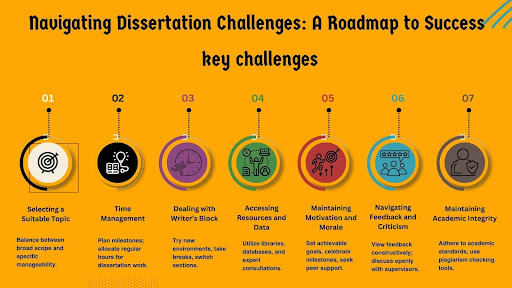
We now understand the dissertation requirements and have already seen some dissertation examples. Let us go through the possible challenges in writing a dissertation.
Writing a dissertation is a significant undertaking, one that comes with its unique set of challenges. Whether you are a first-time dissertation writer or a seasoned academic, understanding these challenges is crucial for success. Here, we delve into some of the most common obstacles encountered during the dissertation writing process and provide insights on how to navigate them effectively.
1. Selecting a Suitable Topic
One of the initial hurdles is choosing a topic that is both interesting and feasible. The topic should be broad enough to allow for comprehensive research but specific enough to be manageable.
| Overcoming the Challenge: Engage in thorough brainstorming sessions, consult with your supervisor, and conduct preliminary research to ensure the topic aligns with your interests and academic goals. For example, a student in environmental science might narrow their focus to the impact of urban development on local ecosystems. |
2. Time Management
A dissertation requires a significant time investment. Balancing this with other commitments such as coursework, jobs, or personal responsibilities can be daunting.
| Overcoming the Challenge: Develop a detailed plan with milestones and deadlines. For instance, allocate specific hours each week for dissertation work and break down the project into smaller, manageable tasks. Tools like Gantt charts can be incredibly helpful in visualizing your timeline. |
3. Dealing with Writer’s Block
Many students experience periods where writing seems impossible, leading to frustration and delays.
| Overcoming the Challenge: Overcome writer’s block by changing your environment, taking short breaks, or switching to different sections of your dissertation. Techniques such as free-writing can also stimulate creativity and idea generation. |
4. Accessing Resources and Data
Gathering the necessary resources, data, or research materials can be time-consuming and sometimes challenging, especially for topics requiring unique or hard-to-find information.
| Overcoming the Challenge: Utilize university libraries, online databases, and academic journals. Don’t hesitate to reach out to experts or institutions for specific data. For instance, a student researching historical events might need to access archives and special collections that are not readily available online. |
5. Maintaining Motivation and Morale
The length and intensity of dissertation writing can lead to demotivation and self-doubt.
| Overcoming the Challenge: Set small, achievable goals and celebrate these milestones. Joining a study group or seeking support from peers can also provide moral and motivational support. Remember, a dissertation is a marathon, not a sprint. |
6. Navigating Feedback and Criticism
Receiving and incorporating feedback, especially if it’s critical, can be challenging and disheartening.
| Overcoming the Challenge: View feedback as a constructive part of the academic process. Engage in open discussions with your supervisor to understand their perspective and use the feedback to refine and improve your work. |
7. Maintaining Academic Integrity
Upholding academic standards, especially regarding plagiarism and proper citation, is crucial and sometimes overwhelming.
| Overcoming the Challenge: Familiarize yourself with your institution’s guidelines on academic integrity. Use citation tools and software like Turnitin to check your work for any unintentional plagiarism. |
Dos and Don’ts of Writing a Dissertation
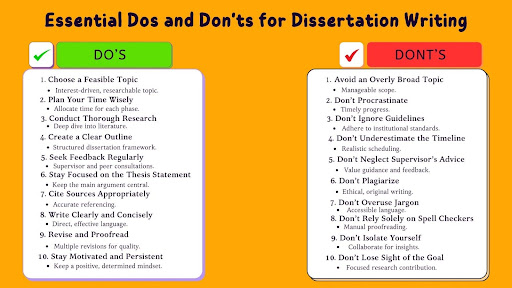
Dos of dissertation writing:
-
Choose a Feasible Topic:
Select a topic that interests you and is researchable within your field.
-
Plan Your Time Wisely:
Allocate specific time blocks for research, writing, and reviewing.
-
Conduct Thorough Research:
Dive deep into existing literature to build a solid foundation for your study.
-
Create a Clear Outline:
Structure your dissertation methodically before starting to write.
-
Seek Feedback Regularly:
Regularly consult with your supervisor and peers for constructive feedback.
-
Stay Focused on the Thesis Statement:
Keep your main argument or hypothesis central in all chapters.
-
Cite Sources Appropriately:
Use the correct citation style and ensure all sources are accurately referenced.
-
Write Clearly and Concisely:
Use simple, direct language to convey your ideas effectively.
-
Revise and Proofread:
Allocate time for multiple revisions and thorough proofreading.
-
Stay Motivated and Persistent:
Maintain a positive mindset and persistence throughout the process.
Don’ts of dissertation writing:
-
Avoid an Overly Broad Topic:
Don’t choose a topic too vast to manage within the scope of a dissertation.
-
Don’t Procrastinate:
Avoid leaving major parts of the work until the last minute.
-
Don’t Ignore Guidelines:
Always adhere to your institution’s format, style, and submission guidelines.
-
Don’t Underestimate the Timeline:
Avoid underestimating the time it takes for research and writing.
-
Don’t Neglect Your Supervisor’s Advice:
Ignoring feedback and guidance from your supervisor can be detrimental.
-
Don’t Plagiarize:
Never use others’ work without proper citation; it’s unethical and can have serious consequences.
-
Don’t Overuse Jargon:
Avoid excessive technical language that could make your work inaccessible.
-
Don’t Rely Solely on Spell Checkers and Grammar Tools:
Automated tools might miss context-specific errors or nuances in language.
-
Don’t Isolate Yourself:
Avoid working in complete isolation; collaboration and discussion can offer new insights.
-
Don’t Lose Sight of the Goal:
Stay focused on the purpose of your research and the contribution it aims to make.
Conclusion
This guide aims to equip you with a comprehensive understanding of what is a dissertation and the dissertation writing process, tailored to meet the challenges and expectations of the current academic landscape. We have also shared some dissertation examples with you.
We delved into the critical components of a successful dissertation, emphasizing the importance of a well-defined thesis, structured methodology, and robust analysis. By highlighting the common challenges faced during dissertation writing, we aimed to prepare you for potential obstacles, ensuring a smoother writing experience.
It is also crucial to keep in mind that external support can elevate the quality of your dissertation. For those seeking further assistance or looking to elevate their dissertation to a professional standard, Content Euphoria’s dissertation writing services and thesis writing services offer a viable solution.
With a team of experienced academic writers and editors, Content Euphoria provides personalized support tailored to your specific needs. Whether it’s refining your thesis, conducting comprehensive research, or polishing the final draft, their expertise can be a valuable asset in your academic journey.
As you move forward, remember that dissertation writing is not just an academic requirement but a journey of intellectual growth and discovery. With the right approach, tools, and dissertation help, you can transform this challenging process into a rewarding and enlightening experience.


